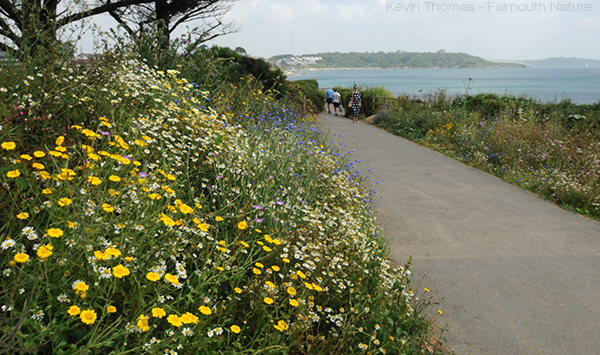Although the South West Coastal path runs for 630 miles the only part allowing access that meets all the requirements of the Disability Discrimination Act is found in Falmouth. Not only does this allow wheelchair users all year round access to the stunning views across Falmouth Bay, it also enables other users such as young families with prams and buggies to enjoy the scenery as well.
This
unique section that runs from Falmouth’s Gyllyngvase beach to the viewing
platform above Swan Pools was created in 2022. The project was a partnership of Natural England and Cormac
with inputs from Cornwall Disabled, Penny Hodgson, Cormac's Countryside Ranger
for the west and the Boscawen Fields Group.
Construction
work that included the widening of the original footpath to allow two
wheelchairs to pass each other was carried out by Cormac. The project
also included the installation of new benches with adjacent space for a
wheelchair to allow people to rest and take in the view.
The Boscawen Fields Group since its inception in 2014 have
raised an amazing £52,500 to fund various projects that have enabled a wider
range of people to enjoy the area. These include creating steps with stainless steel handrails to improve
access from Boscawen Road into two of the fields that lead down to the coastal
path.
The group has also funded the placement of
wooden seats in two fields with a further two on the coastal footpath. Sitting
on one of these on one lucky day I spotted a pod of dolphins or porpoises
jumping in the Bay, a truly magical sight.
Offering panoramic views of the coast and sea, this area is a
very popular part of Falmouth, with two of the fields being a favourite place
for dog walkers to exercise their dogs. One field is kept dog free and in this the group funded the installation
of three stone picnic tables and benches.
As
well as their impressive record of fundraising, the group also carries out a
variety of tasks themselves. The group meets on the first Saturday of each
month to carry out litter picking and work on other projects in the Boscawen
Road fields and along the coastal path.
In
addition to enhancing the area for the local community and visitors alike, the
group has also been involved in work to benefit wildlife such as the creation
of the native perennial wildflower areas in 2019 as part of the charity
Buglife’s Urban Buzz project.
This
year the group has undertaken the creation of wildflower areas alongside part
of the new coastal path and from the photos who can see that they are a mass of
colour. Sitting on the nearby bench I witnessed the enthusiastic reaction of
walkers as they came upon them, many stopping to admire and take photographs.
Just
as importantly was the constant attention they were receiving from a variety of
insects such as butterflies together with both bumblebees and solitary bee
species. Taking an ecological view, I was equally pleased to see a nearby
hedgerow covered in bindweed flowers. Not everyone’s favourite wildflower but
one that has evolved for millions of years playing its part in the web of life.
The
roles that our urban green spaces play is also changing and are much more
varied today than twenty years ago. Many local residents have been persuaded by
people such as David Attenborough who ended Planet Earth II with the words,
“It's surely our responsibility to do everything within our power to create a
planet that provides a home not just for us, but for all life on Earth”.
However,
we live in one of the most nature depleted countries in the world, we have lost
more biodiversity than any G7 country, and we are in the worst 10% globally.
Perhaps surprisingly, many towns now have more varieties of bee species than
are found in the nearby countryside. So, adapting our green spaces can play an
important part in helping wildlife to survive and hopefully one day to recover.
Although
the Boscawen Fields Action Group is relatively small in size it has
accomplished some impressive achievements. With support from our town council,
its activities help to care for and protect this beautiful area of Falmouth for
locals, visitors and Nature.
LINKS:
Boscawen Fields Action Group’s Facebook page: https://www.facebook.com/profile/100076476815163
Falmouth Nature Facebook: https://www.facebook.com/groups/falmouth.nature.uk
Falmouth Nature Instagram: https://www.instagram.com/falmouth_nature/
Falmouth Nature Twitter: https://twitter.com/FalmouthNature



